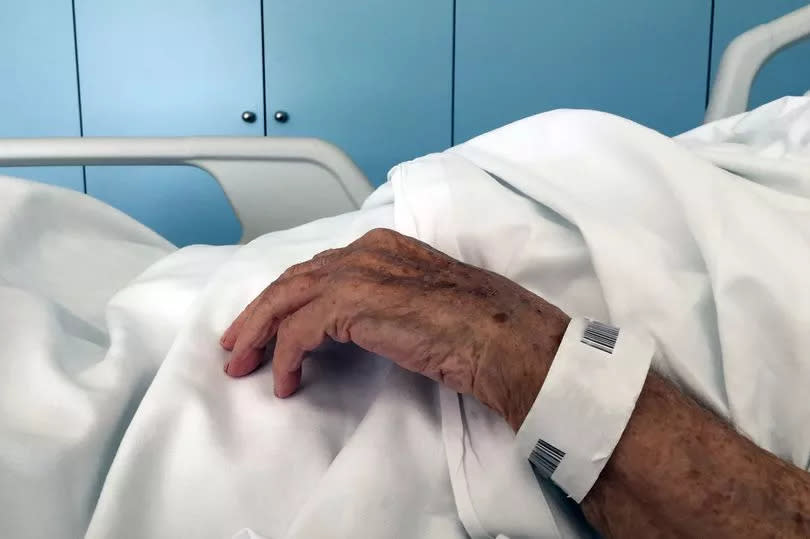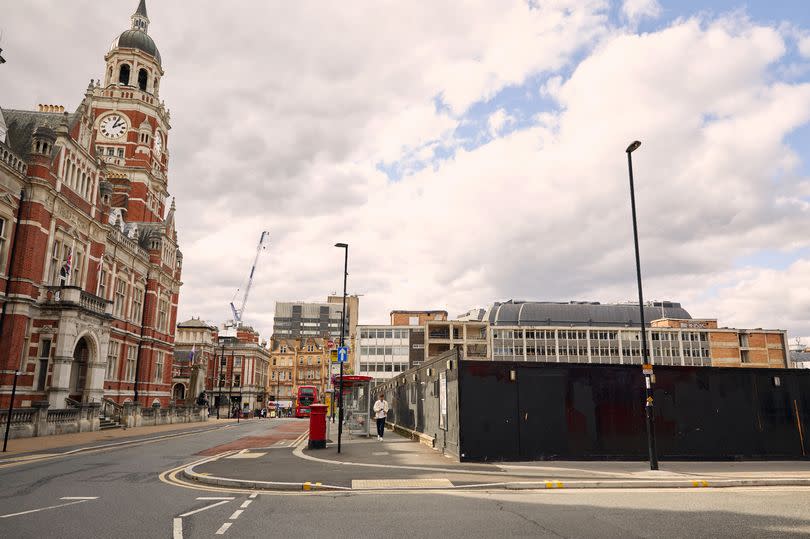He was found with a knife in his neck after a burglary was reported - the truth is more disturbing

Nobody saw what happened the night John Sansom was found with a knife in his neck, slumped on his side three steps from the top of the staircase. Only the 77-year-old's final words hold a clue.
John's friend and flatmate, James Taylor, said the pensioner said he'd been attacked and that the assailant was still hiding somewhere in their flat in Tooting, South London.
The crime scene had the hallmarks of a violent assault. There was blood in the kitchen, on the door and the knife drawer, and a small splatter up the stairs. But Mr Taylor says the doors and windows were 'bolted shut'. The police found no signs of forced entry or a disturbance. Forensics took the 12cm vegetable knife and found nothing on that too. The intruder was only ever seen by John.
After nearly two years, in which police investigated these strange circumstances, reviewed their findings, and still took no further action, the most likely explanation might seem unlikely, yet better than any alternative. Was the intruder even real? Did John somehow stab himself? These were the questions facing assistant coroner Victoria Webb during an inquest at the South London Coroners' Court on Monday, June 17.
READ MORE: Child abuse addict flashed sick rape videos at kids on Omegle and secretly filmed naked boy

On October 2, 2022, Mr Taylor called 111 with concerns about John and they were booked to see a GP. At this week's inquest, Mr Taylor produced a handwritten note from his pocket and handed it up to Ms Webb. Apparently, it was from the GP, sharing his concern that John would be unsafe at home without a carer and that he should not be discharged from hospital while still delirious.
John went to Croydon University Hospital the next day, on October 3, when he was diagnosed with a urinary tract infection, said to be linked to his delirium. He was sent home late that night with a course of antibiotics, but, at around 5am that night, Mr Taylor left his room to go to the toilet and saw the hair on John's blood-soaked head glistening in the unexpected glow of the stairwell lightbulb.
Over the preceding 48 hours, Mr Taylor said John was 'very confused' and 'very quiet'. He wanted to see a doctor, but at the surgery he he told his GP he did not need to be there, seeming to forget why they had booked the appointment in the first place.
After his visit to hospital, John got straight into bed without closing the door, something Mr Taylor said 'never happened' before. "He did say he felt 'really bad'," Mr Taylor recalled. "I said you will feel better in the morning if you have a good night's sleep."
In the morning, when he found John collapsed on his left side with blood in his hair, he assumed he'd fallen down on a patch of stairs he'd had trouble with before. They were steep, the carpet was worn, and John was 'very unsteady' on his feet, Mr Taylor said.
After falling down some steps in the garden in March 2022, John broke his hip and collarbone and required a Zimmer frame. It wasn't unusual for him to fall when Mr Taylor wasn't there, and his bones were already weak from osteoporosis.
'He was convinced someone was in the house'
So when Mr Taylor saw John on the stairs, he called 999. It was then, he claimed, John spoke to him about an 'attacker'.
"He said somebody had broken into the house and was still there," recalled Mr Taylor from the witness box at Croydon Town Hall, "He seemed to be convinced there was a burglar in the house. I did have a look and there was nobody around. The back and front door were locked and bolted."
In the kitchen, Mr Taylor noticed more blood, so he sat down with John and asked him again. John maintained his troubling story. Then Mr Taylor said he noticed more blood. This time on John's right arm. "I thought that's a bit odd," he told the court. Moments later, John moved his body, exposing the knife stuck in his neck.
Shocked at the grisly sight, Mr Taylor called 999 for the second time. A transcript of the call shows Mr Taylor told the call handler John was 'rambling' and reported the blood on the kitchen door. Soon a paramedic from the London Ambulance Service arrived, but alone. The 'distressing' sight that confronted her is something she still remembers well.
Upon entering the flat, she found John with a knife handle protruding from his neck. By herself Ms Whitehouse felt 'vulnerable and concerned for her own safety', but she carried on with her job. After finding John's pulse and establishing he could breath, she waited for backup. John was able to squeeze her hand on request, but when she asked if he had been attacked there was no response.
When he changed his position on the stairs, the knife slipped out of the wound. Paramedics, who were now on the scene, then moved him to a bed where they discovered another stab wound to his chest. After observing cuts and scrapes, that she considered 'did not occur after falling', Ms Whitehouse made a safeguarding referral to report her suspicions.
'Not typical of assault-related injuries'
At St George's University Hospital, doctors confirmed 11 injuries, including the stab wound to the neck and chest, puncturing the lung, plus fractures to the ribs and spine. John's stab wounds were treated and his fractures managed conservatively, but on October 13 he was diagnosed with hospital-acquired pneumonia.
On October 21, he failed spontaneous breathing and had to be ventilated. Then on October 24, his blood oxygen levels decreased, requiring more ventilation. From here he deteriorated and died on October 25.
Detective Sergeant Suzanne Harris, from Bromley CID, reviewed the case and confirmed there would be no further action after enquiries were made about third-party involvement. DS Harris said Mr Taylor's account was consistent and had been corroborated by the GP and the findings of the pathologist report and post-mortem.
But, police were unable to ever get an account from John himself. His mouth was covered with an oxygen mask as he was conveyed to hospital, and attempts to speak to him as he lay dying at St George's were fruitless.
DS Harris confirmed there was blood on the knife drawer, on the kitchen door, and in a trail leading towards the staircase. But she said 'there was no sign of any disturbance' and forensics had been unable to find any markings on the knife. Asked if the position of the knife made sense to her, she said 'Yes', though conceded it had appeared 'unusual' at first.
The stab wound to the chest passed between two ribs and punctured a lung, while the stab wound to the neck turned out to be 'superficial' and was 'easily treated' by surgeons. It turned out neither was as bad as they looked, in the view of the forensic pathologist, Dr Olaf Biedrzycki, John's medical cause of death was respiratory failure caused by bilateral pneumonia, that caused by complications from his multiple injuries.
While the post-mortem 'could not rule out third-party involvement', Dr Biedryzycki said the majority of the injuries were 'not typical of assault-related injuries', and could be explained by a fall forward. The court heard he was 'content' the stab wounds could have been self-inflicted, even though John's right-handedness did not align with the location of the wounds on his left side.
'John sustained self-inflicted wounds'
Asked for his theory on the case, Mr Taylor told the court: "I can imagine he thought there were intruders in the house and the drawer was open. I think he imagined there was people there and he stabbed himself accidently."
He also suggested John had fallen on his way up the stairs, rather than backwards.
Ms Webb came to the same conclusion when recording her verdict, first recalling the events that led up to John's death, his previous falls and medical conditions that made him 'sleight' and weak-boned. She said he had gone to bed 'feeling unwell', then told Mr Taylor someone had broken in when he found him on the stairs in the early hours of the morning.
"However, this was not correct and John was imagining this," said Ms Webb. "It's more likely than not, John had self-inflicted stab wounds to himself, however, I do not find these particular injuries are a significant factor in his death... I find it more likely than not John fell on the stairs and sustained injuries that were seen in hospital."
After giving the medical cause of death as respiratory failure, Ms Webb added: "John sustained injuries in an unwitnessed fall at home and he subsequently died in hospital due to those injuries... I'm content a UTI causing confusion might have been the cause of the fall on that occasion."
Giving her narrative conclusion, Ms Webb said: "In the early hours of October 4, John sustained self-inflicted wounds at home while suffering confusion due to a UTI for which he had treatment. Shortly after he fell on the stairs at home, sustaining significant orthopaedic injuries which led to the development of pneumonia from which he died on October 25 2022."
Got a story or a court case we should cover? Please email callum.cuddeford@reachplc.com or WhatsApp 07580255582
Don't miss out on the latest crime stories from across London. Sign up to MyLondon's Court & Crime newsletter HERE

 Yahoo News
Yahoo News 
